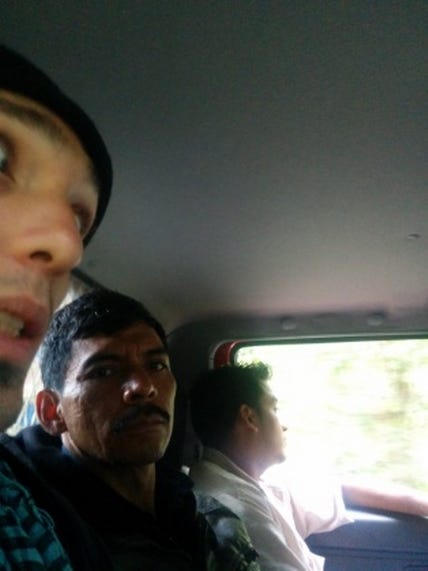Cacao, Community, and Comida: Journeying into the Heart of Mexico Profundo
The Cacao Communiqués (Vol. 1)
Cacao, Community, and Comida: Journeying into the Heart of Mexico Profundo (Originally Published in 2015.)
It all started about a year ago — in San Marcos, Lake Atitlan, Guatemala. There, I had the honour of participating in, of all things, a cacao ceremony. What followed was a journey down the spiral staircase into the heart of Oaxacan cacao, the heart of Mexico, and the heart of hospitality. Upon returning home, an invitation appeared to attend a talk given by chocolate maker Michael Sacco, entitled “The Twenty Teachings of Cacao.”
I have lived long enough to know serendipity when it’s pulling me by the hair. That night, Michael spoke succinctly and poetically about the life, biology, taste, history, and legacy of this beautiful seed and its place in Mesoamerican civilization. Afterwards, we spoke briefly and unknowingly planted the seeds that would bring me deep into the birthplace of chocolate.
Later, I followed up with a request for resources. Michael obliged in the form of a reading list. Six months after our initial meeting, his reading list sat on my shelf, waiting. However, as the Mayans know so well, timing is everything. I began volunteering at his Toronto storefront, ChocoSol and subsequently engaged in a scholarship with this Doctor-in-training of Indigenous Studies and Choco-Sabio. Learning in new ways threw away the cultural lens, while also holding it up to the light.
Back to School
I learned about the Popol Vuh — a Mayan holy book that describes the creation of the world and humans, about ka-ka-ow, about Mesoamerican civilization, about the differences between Mexico Profundo (indigenous Mexico) and the Mexico Imaginario (modernity-noosed Mexico). Next was indigenous praxis that continues to break ground despite the weight against it. I began to understand the intellectual arrogance Western culture has used to smother other cultures and lives. Being cooked was a good way to describe this time. Like a seed being broken open so that new life might flourish, my culture-bound perceptions and biases were cracking, like an egg about to be fried on the embers of a still intact, living culture.
Now, truth be told, I tend to take an annual dip south into more tropical climates. Not to binge and burn, but to sit and learn from people that might have something radically different to say about life than that which surrounds us in North America. This time, that place would be Mexico, and this time I would go with a mission of sorts, as a ChocoSolista.
My mission, if I chose to accept it, would be to visit Oaxaca and Morelos states in southern Mexico. With newly formed and lenticularized spectacled lenses, I might learn from the lived experience of my time in the Mexico Profundo. All of this, while sharing ChocoSol chocolate with Oaxacan cacao producers at the grassroots level. Without hesitation, I accepted and packed my giant, tin foil-covered, hashish-like chocolate package into my bag and left.
Morelos
First, I arrived in Tepoztlan, a small pueblo magico in the state of Morelos, an hour’s drive south of Mexico City. Tepoztlan is a serenely popular weekend destination for chilangosi, as well as hippies and new-agers. The food traditions of Tepoztecos have survived five hundred years of Spanish and Mexican influence. At first, I didn’t understand why it would be so important. Yet, recalling the slow disappearance of my grandmother’s food from the family feasts after she died, this history started making more and more sense.
A colonial culture can and usually does make all attempts to force conversion. However, if the indigenous culture remains rooted in place, it is more likely their food will retain the flavour of those roots. It is more likely the “recipes”ii will retain their lived memory, even if some things do not (i.e. language, customs, ritual). This is perhaps most obvious when one looks at North American cities, where the diverse diasporas are represented most visibly by restaurants dedicated to their homeland’s cuisine. Moreover, it is not just the memorial lineage of the food itself that survives. It is never just the thing in question, but the perspective one maintains. This includes the shared experience of how that thing, in this case, food, comes to inform us about how we are nourished.
Comida
In Grassroots Post-Modernism, elder Gustavo Esteva speaks of a traditional culture of comida found in Mexico. Comida translates to “food, or meal,” but its nature goes much deeper. Comida is a way of life that would be closely related to gift economics. For the people who practice it, however, comida is not a subcategory of a modern redefinition, but an ancient root of the tree of life. In Mexico, it is quite literally a foundation felt and shared apriori of its conceptuality. The lived practice comes first, only the theory thereafter.
At the very least, comida is a communal imperative to share one’s food, with every attention given to “impostura”iii — the affection, togetherness, and understanding embedded in such an act.
Food is shared without any conception of resultant expectation or recompense — it is just what is done. One is not feeding the other. Instead, one is feeding the village, and the community.
Moreover, comida cannot be considered charity but a form of communal solidarity that seeds and maintains impostura. As journalist Eduardo Galeano wrote:
“Charity is humiliating because it is exercised vertically from above; solidarity is horizontal and [has a foundation of] mutual respect.”
At best, comida cannot be defined directly. I don’t know if the English language, so couched in individualistic reductionism, can do it justice. Perhaps it can be said that comida and impostura amount to the process of being together and honouring what that means, demands, and offers. Within these practices, authentic comunalidad can be born and thrive. They are both the seeds and the fruits of communal bonding.
Comidantes
Tepoztecos tell a story that unequivocally reinforces the humility that is demanded by engaging in comida:
“[Their] ancient king [sic] once returned to his village after a long and difficult journey. Dirty, his clothes shredded into rags, he was unrecognizable to his people, who threw him out of the feast they were celebrating at the time of his arrival. Enraged and saddened by the treatment meted to him by his own people, he went to his palace and, putting on his royal finery, returned to the feast. Now recognizable, he was immediately honoured with the best food available. “
“The [king] took this food and splattered his clothes with it, saying ‘You are hosting the clothes, not the person inside them. Let these clothes, then, have your food; it has not been cooked for real men and women.’ Immediately, he returned to his mountain. Since that day, the doors of the houses of every Tepozteco and Tepozteca remain open at all their many feasts and barrio celebrations. Strangers are now customarily invited to join and enjoy … communal hospitality at feasts for hundreds with the convivial preparation of neighbours.”
Such hospitality was very much evident during my stay. This, both in spite of and despite the annual carnival fiesta bringing in tons of rowdy chilangos and other foreigners. Perhaps the above story is a reason why so many urbanites come down to this tiny pueblo. There is a sense or air of authenticity and belonging, a remembering even, that is often hidden if not invisible in metropolises like Mexico City, where almost everyone is from somewhere else.
Oaxaca
After a week in Tepoztlan the wind was blowing me far from the crowds of carnival and sweeping me into the dusty valley that holds Oaxaca City. Here, I met the amazing Juan Antonio Canseco, a local ChocoSolista who proceeded to give me an insider’s tour of the city’s best pre-Hispanic food. Such comida is found in the markets: the late-night memelas and mole and mezcal. The early morning champurrado and tamales. The midday tlayudas and tejate. The all-day & all-night tortillas. (Excuse me, please allow me to wipe the drool from my lips.) More than simple flavours and ancient recipes, the food of Oaxaca is so firmly rooted in its diverse indigenous cultures,iv it would be hard to imagine any part of the culture existing without it.
After a few days of waxing Oaxaqueno, we packed up and headed out to a small pueblo via the town of Valle Nacional (5hrs from Oaxaca City). Nestled in a lush valley with soaring green mountains, this was where local producers grow Oaxacan cacao, coffee, tobacco, achiote, mamey, bananas, and oranges. I was introduced to our hosts. Don Max and his family engaged us with a kind of hospitality most Westerners can’t even dream of. They invited us, strangers, into their home as family — a type of generosity few can pay for. We were welcomed, given beds to sleep in, food to eat, smiles to return, and some work to do.
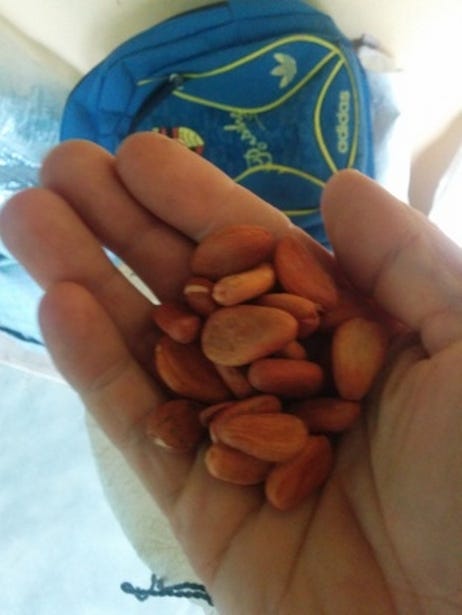
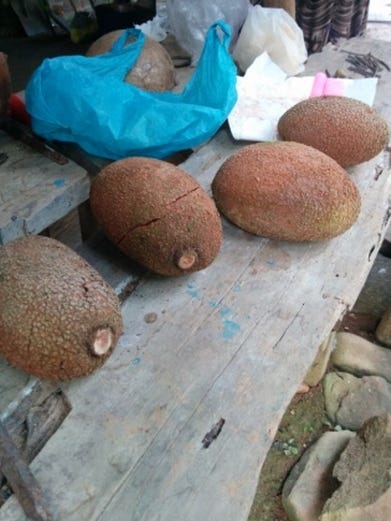
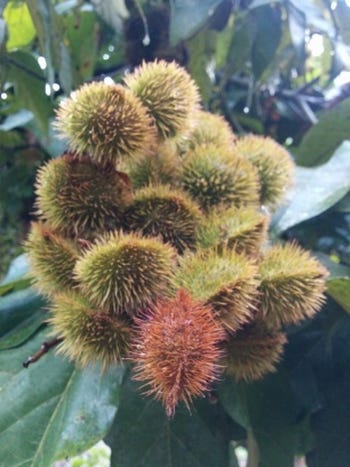
The Village
The village life here is intensely huddled between traditional ways and modern means. At that time, the village’s administrative secretary was “volunteering” in the position for a full year before he would be allowed the position permanently. Only at the end of that solar cycle would he begin to be paid for his role. During this year of servicio, he is compensated unofficially by neighbours’ gifts of food and domestic help. However, this man had already spent 5 years studying and working in the United States. He seemed caught between having to earn his position as a village administrator and the hushed whispers of rights-based cultures that gawk at having anyone do a job “for free.” The dissonance cracked his voice and lowered his head.
Our first day of village life came and went quickly. The delicious taste of fresh, yellow tortillas, the crisp mountain air, and the rush of hospitality settled our bellies to sleep. Throughout the night, the spirit and sound of the rushing river nearby came through the cabin and into my dreams. It gave them a vivid effervescent glow in the rearview mirror of my memory. Many of the villagers had worked in the United States at some point. Yet, their culture, their language and customs were still alive and present, much like the land around them.
The Work
After a delicious breakfast, Don Max, Juan Antonio and I took off to meet the productores — the families whose laboured fruits had unknowingly brought me here in the first place.
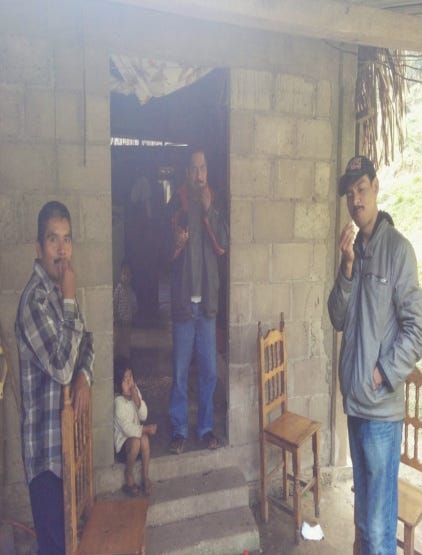
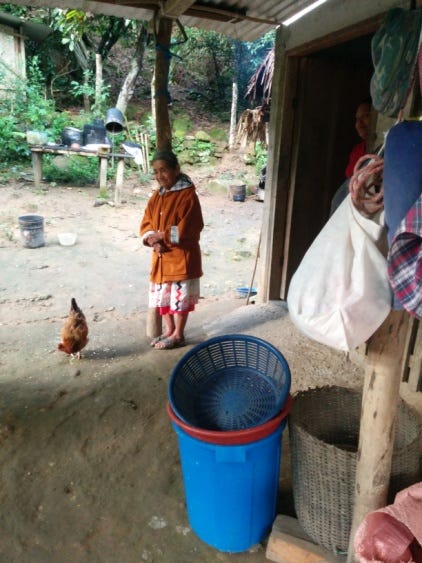
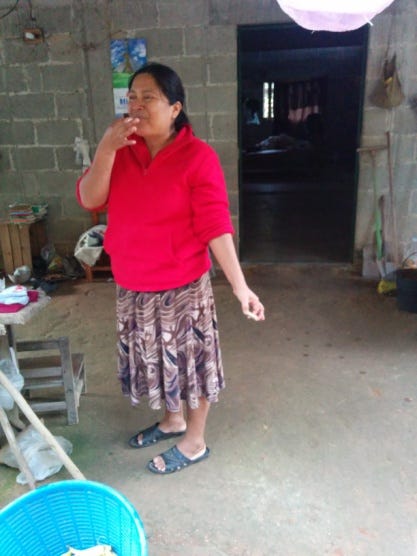

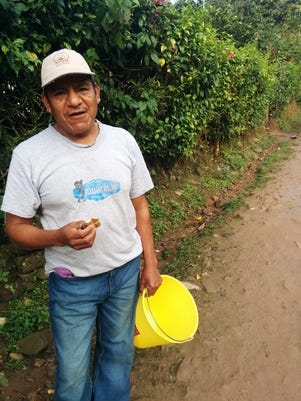
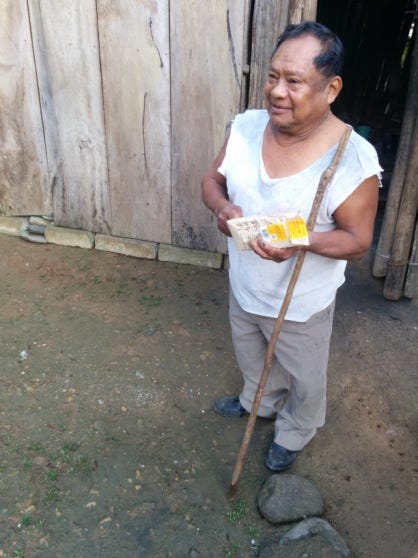
Since many of the locals speak Chinanteco and because Spanish is their second language, Don Max did most of the speaking. He introduced me and informed the productores I had travelled from Canada to share with them their rare, white Oaxacan cacao, transformed into chocolate. The initial introduction was a little awkward. Who knows how many missionizing types that look like me previously appeared on their doorsteps with good intentions? The work of ChocoSol, however, is to remedy those relationships through sincere and just interculturality. The villagers, tasting their very own Jaguar chocolate, lit up with smiles and laughter. The type people have when they’re too content to speak. A Cheshire cat grin emerged, the chocolate ringing around their lips, acknowledging the reciprocal work and dedication melting in their mouth.
Suddenly, a waft of choco-happiness brought a swarm of frenzied children. They came running like elated locusts. Truthfully, they were only a few, but excited to taste the magical beans pressed into cho-co-la-te. With the stroke of a hand being pulled from a package and a fist unravelling, I became their new best friend and emphatically sealed my fate for the next 3 days.
Communalidad
Community here is broader and deeper than most Westerners know and can imagine. These child-neighbours of Don Max stole in and interrupted meals in houses not their own. They woke me up and watched me fall asleep. This, in the hopes they might get another piece of the mouth-watering “CHIK-O-LATA,” as Christian Alexi so flamboyantly called it. In no subtle way, the house of Don Max was the house of all these kids. They were allowed to roam freely without reprimand, but with a soft and lucid respect for his home.
For Gustavo Esteva and the traditions he speaks of, ideas of community and hospitality are bound up together. One is not expressed in its fundamental nature without the other. “Traditions of hospitality are kept alive only by those who enjoy and participate in communal memory.”v
Tequio
On the third morning, I woke up to see only Don Max’s wife and daughters. Don Max’s son Beto had arrived from Valle Nacional, the feeder town. He advised me that his father had left to join the community for a tequio. During this village’s “work parties,” the able-bodied men go door-to-door to assist fellow residents. The men ask each neighbour if they need help with any projects or if their houses need repairs. Although it is expected, the men do this voluntarily every two to three months. Such commitment and selflessness left me staggered. I sat there all morning thinking about how beautiful such a “chore” is. That is, not the fact that this was a committee or group, elected to do so, but the opposite. It was the community constructing and reconstructing community together, licking its own wounds.
As Rumi says, “The wound is the place the light enters.” This communal work doesn’t just accomplish practical tasks, but it seemed to me to bind and strengthen the collective woven story of the people.
Later in the morning, Don Max returned. Beto, his dad and I began packaging all the dried Oaxacan cacao blanco into huge white, food sacks, sealed and ready to be shipped to ChocoSol in Toronto. While we packaged, Don Max’s daughter and wife prepared some tortillas and beans as the men stuffed the sacks. While Beto had set up an athletic clothing store in Valle Nacional, he seemed quite proud to work with his father in this way. Later, he gave me a tour of their land and the myriad Oaxacan cacao, achiote, orange, and avocado trees they had growing there. They even allowed me to chop down a pod and engage in the ritual cacao fruit-sucking that surely gives chocolate its addictive qualities.
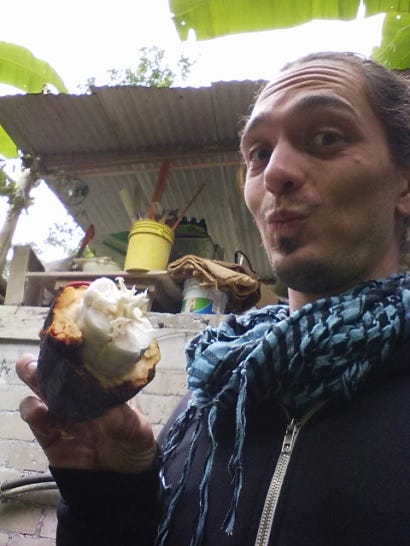
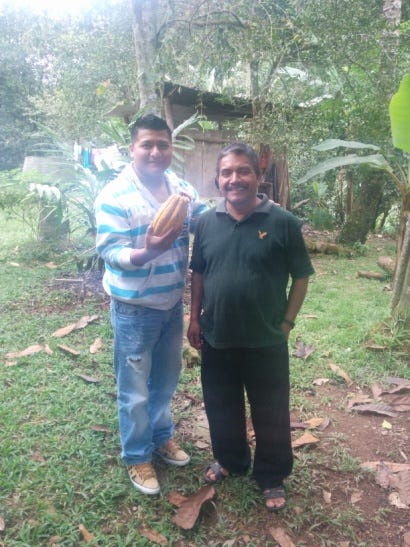
The Return
After a few days, my time in the village was up. I had shared as much chocolate as I had brought with me. Next, I spent another half week in the Sierra Norte and Mazateca of Oaxaca, experiencing stunning views, amazing food, and ancient languages. When I returned to Oaxaca City, I met back up with Juan Antonio and we continued our ritual food binges until it was time to be on my way.
Back in Toronto, I ruminated on community, home, and ancestry. Being a 2nd generation, mostly Anglo-Canadian, what concerned me wasn’t so much my version of these themes, but what authentic versions of these look like. With the right combination of humility, connections, and literature, I found myself unveiled — not absorbed into the Mexican experience, but temporarily unbound to the filter of Western culture.
Foreshadowing
Deeply immersed in the history, the culture, the land, and the people, I began to see the real deep differences between the indigenous mountain pueblos of Mexico Profundo and fabricated beach resorts and westernized metropolises of the Mexico Imaginario. From inside Mexico Profundo, there was an uncanny sense from an outsider’s point of view, that this might be what it means to belong to a place, and not just to be in a place. From a glimpse of Mexico Profundo and its inner veins — the dendritic, reinforced bonds within its communities, the whispers of rooted, village-mindedness echo into the present and even unto the foreigner.
The many Tepoztecos, Oaxacans, and Chinantecos I met on my journey showed me some of the tools that can be utilized if we choose to return our fragmented, individualistic society to a place that champions realized and ritualized community. The reciprocal relationships between those in Toronto and Oaxaca produce seeds that ChocoSol and its cacao-producing companeros are planting in both places. This tree is starting to branch and the buds are starting to show, and if we can fertilize the seeds that have fed a people through centuries of conquest and domination, then perhaps we, as North Americans, so visibly uprooted from our indigeneity, can start to branch off towards a re-imagining, a homecoming of what authentic community and communing looks like. This is just an example. There are many more out there. As the grandfather of the psychedelic subculture, Timothy Leary, once famously said, “Find the others.”
i Reference to residents of Mexico City. Original meaning was Mexicans who moved to Mexico City from another locale.
iiI put this in quotes because many cultures do not write down or formalize the preparation/ingredients of regional dishes. They are left open to interpretation by their various inheritors/descendants.
iii “Impostura… connects affectionate people, full of neighbourliness; not ‘managed’ by institutions, but free, alive and autonomous precisely because of their personal bonds; with their roots nourished by their traditions; in worlds where commodities play a marginal role and the environment is largely occupied by the commons.” Esteva, Gustavo, Grassroots Post-Modernism (pp. 63)
iv 16 unique languages in the state alone
v Esteva, Gustavo. Grassroots Post-modernism.







